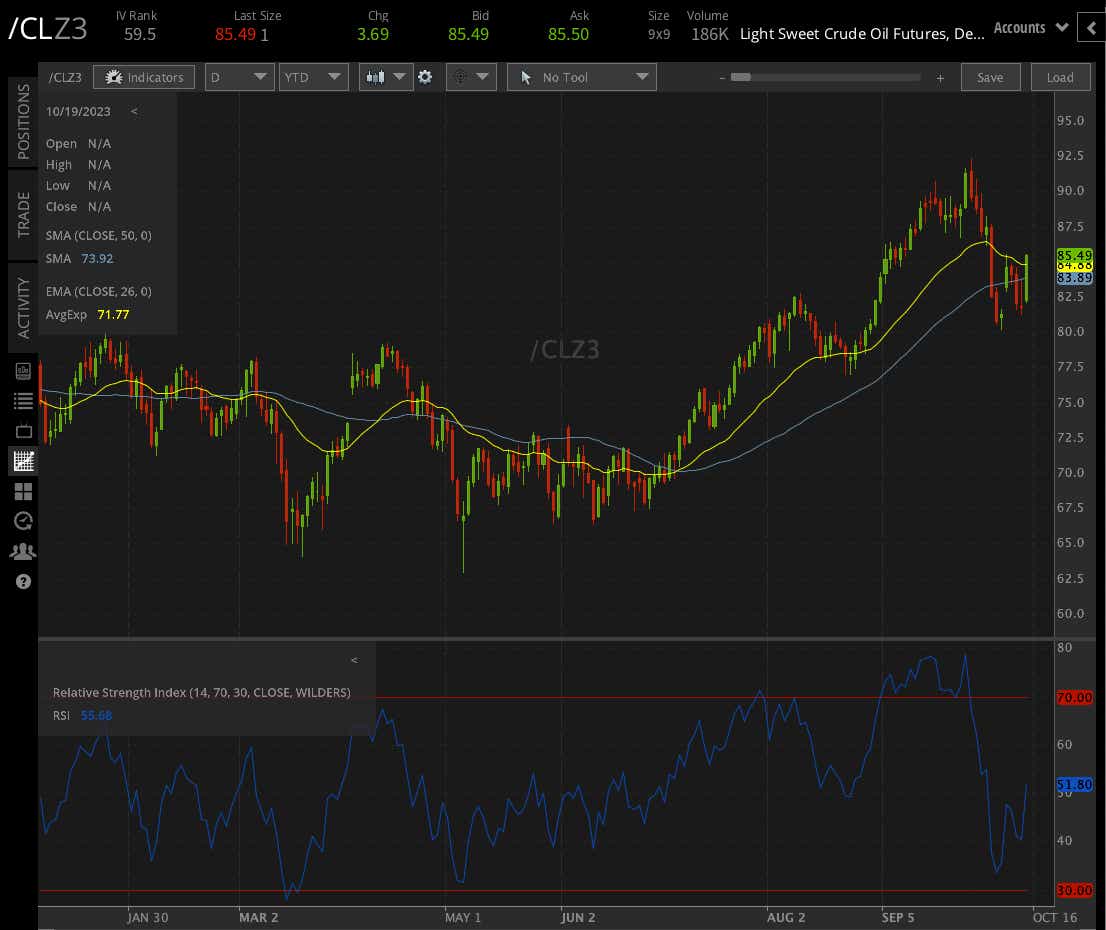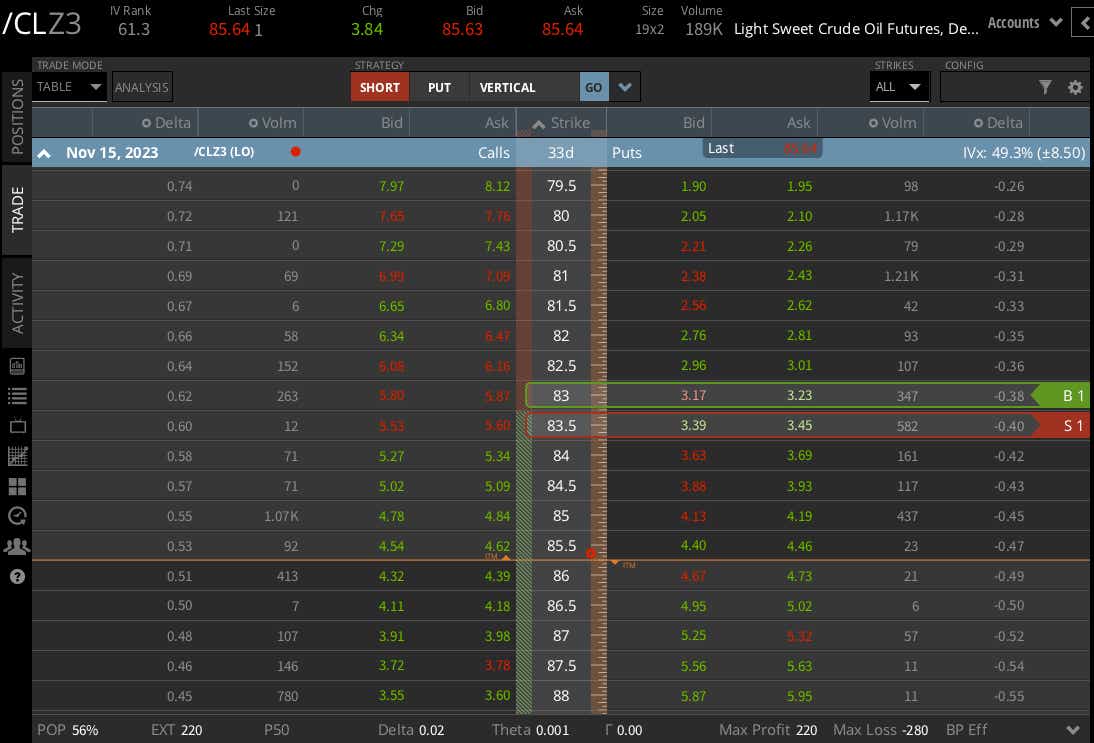Crude Oil Surges as U.S. Targets Russia's Shadow Fleet

Crude Oil Surges as U.S. Targets Russia's Shadow Fleet
Disrupting illicit "shadow" flows from Russia, which will further limit global oil supply at a time when OPEC is already committed to its production cuts
- Crude oil prices rise as U.S. signals tighter sanction enforcement.
- Middle East tensions keep traders on edge as conflict escalates.
- Technical outlook for oil futures improves as prices clear resistance.
Crude oil prices (/CLZ3) rose $3.6 per barrel to trade at 85.40 Friday afternoon, marking the largest one-day percentage gain since early April at about 4.5%. Meanwhile, the CBOE’s Crude Oil Volatility Index—like the CBOE Volatility Index (VIX) but for oil—surged nearly 10% to hit its highest level since May. Commodity markets as a whole appear to be advancing.
U.S. tightens enforcement on Russian oil
The Office of Foreign Assets Control, a part of the U.S. Treasury’s Office of Terrorism and Financial Intelligence, posted an advisory that warns the maritime trade industry to abide by sanctions put in place by the Price Cap Coalition—which includes the G7, European Union, and Australia.
Energy traders see this disrupting shadow flows from Russia, which will further limit global oil supply at a time when OPEC is already committed to its production cuts. The shadow trade of oil refers to ships that are engaged in the illicit trade of oil with the specific intent to sidestep sanctions. The advisory reflects the intent of the coalition to step up its enforcement efforts against these so-called shadow trade.
Geopolitical tensions add to bullish sentiment
Meanwhile, the Middle East is witnessing increasing geopolitical tensions as Israel prepares for what appears to be a massive ground assault into Gaza. Energy traders are concerned that the conflict could drag Iran or other actors into the fighting, posing a further threat to oil flows in the region.
Last week’s incursion by Hamas militants was met with cheers by some in Iran, Iraq, Syria, Lebanon and Yemen. However, these outside actors have not taken any tangible actions beyond that. But with any dynamic conflict, that may quickly change, and that is keeping oil traders on edge.
Many military analysts believe this conflict differs from previous instances of violence in the region and could reshape the political landscape permanently. Energy traders need to incorporate this into their market assessments, although accounting for the many variables is nearly impossible. As of now, volatility is likely to persist as the situation develops.
Oil Technical outlook
Today’s move put prices above two key moving averages—the 50-day simple moving average and the 26-day exponential moving average. The relative strength index’s 50 mid-point was also pierced on Friday, bolstering the commodity’s bullish posture. The next area of likely resistance exists at the September 92.48 swing high.

What is the trade?
Crude oil futures currently hold an IV Rank (IVR) of 59.9. That is offering some juicy premium for selling premium. While traders need to be aware of the volatility in the product, selling a spread may help to limit exposure to wild price swings if directionally wrong.
For those waiting to get short oil, it may be best to wait until price get near that September high and sell call spreads. For those wanting to get long now, selling a put spread for the November 15 contract around the 40 delta with a short 83.5 put and a long 83 put is a potentially rewarding play with a 56% POP.

Thomas Westwater, a tastylive financial writer and analyst, has eight years of markets and trading experience. @fxwestwater
For live daily programming, market news and commentary, visit tastylive or the YouTube channels tastylive (for options traders), and tastyliveTrending for stocks, futures, forex & macro.
Trade with a better broker, open a tastytrade account today. tastylive, Inc. and tastytrade, Inc. are separate but affiliated companies.
Options involve risk and are not suitable for all investors. Please read Characteristics and Risks of Standardized Options before deciding to invest in options.
tastylive content is created, produced, and provided solely by tastylive, Inc. (“tastylive”) and is for informational and educational purposes only. It is not, nor is it intended to be, trading or investment advice or a recommendation that any security, futures contract, digital asset, other product, transaction, or investment strategy is suitable for any person. Trading securities, futures products, and digital assets involve risk and may result in a loss greater than the original amount invested. tastylive, through its content, financial programming or otherwise, does not provide investment or financial advice or make investment recommendations. Investment information provided may not be appropriate for all investors and is provided without respect to individual investor financial sophistication, financial situation, investing time horizon or risk tolerance. tastylive is not in the business of transacting securities trades, nor does it direct client commodity accounts or give commodity trading advice tailored to any particular client’s situation or investment objectives. Supporting documentation for any claims (including claims made on behalf of options programs), comparisons, statistics, or other technical data, if applicable, will be supplied upon request. tastylive is not a licensed financial adviser, registered investment adviser, or a registered broker-dealer. Options, futures, and futures options are not suitable for all investors. Prior to trading securities, options, futures, or futures options, please read the applicable risk disclosures, including, but not limited to, the Characteristics and Risks of Standardized Options Disclosure and the Futures and Exchange-Traded Options Risk Disclosure found on tastytrade.com/disclosures.
tastytrade, Inc. ("tastytrade”) is a registered broker-dealer and member of FINRA, NFA, and SIPC. tastytrade was previously known as tastyworks, Inc. (“tastyworks”). tastytrade offers self-directed brokerage accounts to its customers. tastytrade does not give financial or trading advice, nor does it make investment recommendations. You alone are responsible for making your investment and trading decisions and for evaluating the merits and risks associated with the use of tastytrade’s systems, services or products. tastytrade is a wholly-owned subsidiary of tastylive, Inc.
tastytrade has entered into a Marketing Agreement with tastylive (“Marketing Agent”) whereby tastytrade pays compensation to Marketing Agent to recommend tastytrade’s brokerage services. The existence of this Marketing Agreement should not be deemed as an endorsement or recommendation of Marketing Agent by tastytrade. tastytrade and Marketing Agent are separate entities with their own products and services. tastylive is the parent company of tastytrade.
tastyfx, LLC (“tastyfx”) is a Commodity Futures Trading Commission (“CFTC”) registered Retail Foreign Exchange Dealer (RFED) and Introducing Broker (IB) and Forex Dealer Member (FDM) of the National Futures Association (“NFA”) (NFA ID 0509630). Leveraged trading in foreign currency or off-exchange products on margin carries significant risk and may not be suitable for all investors. We advise you to carefully consider whether trading is appropriate for you based on your personal circumstances as you may lose more than you invest.
tastycrypto is provided solely by tasty Software Solutions, LLC. tasty Software Solutions, LLC is a separate but affiliate company of tastylive, Inc. Neither tastylive nor any of its affiliates are responsible for the products or services provided by tasty Software Solutions, LLC. Cryptocurrency trading is not suitable for all investors due to the number of risks involved. The value of any cryptocurrency, including digital assets pegged to fiat currency, commodities, or any other asset, may go to zero.
© copyright 2013 - 2025 tastylive, Inc. All Rights Reserved. Applicable portions of the Terms of Use on tastylive.com apply. Reproduction, adaptation, distribution, public display, exhibition for profit, or storage in any electronic storage media in whole or in part is prohibited under penalty of law, provided that you may download tastylive’s podcasts as necessary to view for personal use. tastylive was previously known as tastytrade, Inc. tastylive is a trademark/servicemark owned by tastylive, Inc.